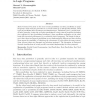Free Online Productivity Tools
i2Speak
i2Symbol
i2OCR
iTex2Img
iWeb2Print
iWeb2Shot
i2Type
iPdf2Split
iPdf2Merge
i2Bopomofo
i2Arabic
i2Style
i2Image
i2PDF
iLatex2Rtf
Sci2ools
EUROPAR
1995
Springer
1995
Springer
Relating Data-Parallelism and (And-) Parallelism in Logic Programs
Much work has been done in the areas of and–parallelism and data parallelism in Logic Programs. Such work has proceeded to a certain extent in an independent fashion. Both types of parallelism offer advantages and disadvantages. Traditional (and–) parallel models offer generality, being able to exploit parallelism in a large class of programs (including that exploited by data parallelism techniques). Data parallelism techniques on the other hand offer increased performance for a restricted class of programs. The thesis of this paper is that these two forms of parallelism are not fundamentally different and that relating them opens the possibility of obtaining the advantages of both within the same system. Some relevant issues are discussed and solutions proposed. The discussion is illustrated through visualizations of actual parallel executions implementing the ideas proposed.
Data Parallelism | Data Parallelism Techniques | Distributed And Parallel Computing | EUROPAR 1995 | Parallelism Offer Advantages |
| Added | 26 Aug 2010 |
| Updated | 26 Aug 2010 |
| Type | Conference |
| Year | 1995 |
| Where | EUROPAR |
| Authors | Manuel V. Hermenegildo, Manuel Carro |
Comments (0)

